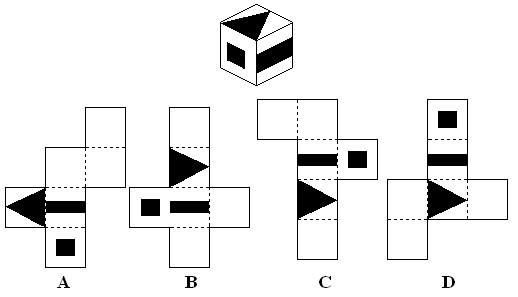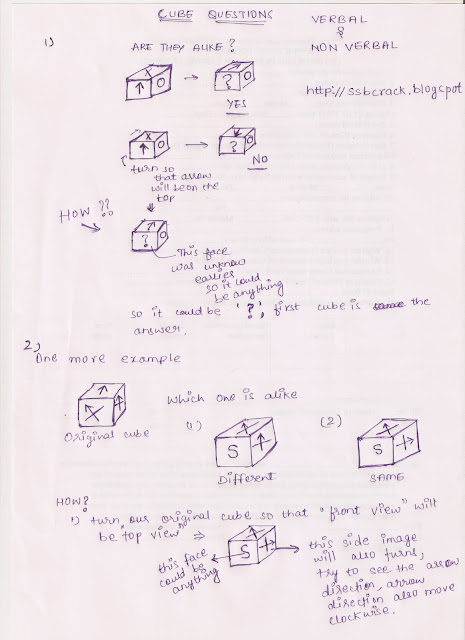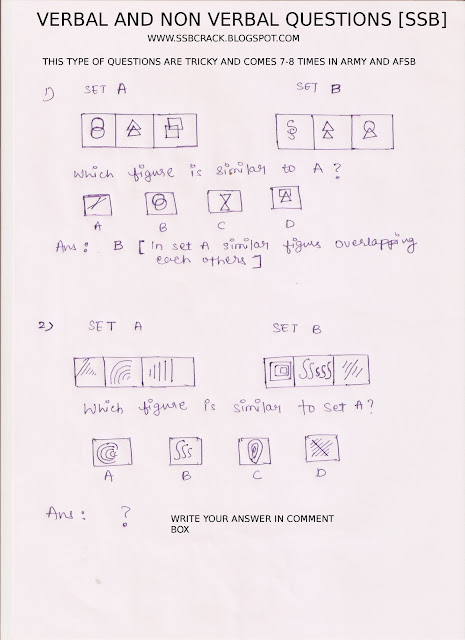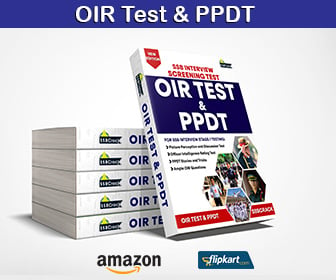You might have faced few tricky questions in verbal and nonverbal tests on SSB day 1, mostly these questions consist of a dice problem or finding the alike cubes. Just to familiarize freshers with these types of questions, we have solved few questions below. Though it’s very easy, try to understand the concept to do it fast because the time given is less.

SSB Cube Questions
These questions consist of cubes and you need to find the cubes which are similar. Read the instructions below to understand the real misery behind this type of question.

SSB Similar Figure Questions

Type of Question in Verbal Ability:
- Completion of Series: In this type, a series is given in which a word, letter, a figure or digit is missing somewhere in between or at the end and the candidate is required to insert it.
- Example 1: Find the missing, 3,7,11,15,__,__ Ans: ( write it in the comment box)
- Relationship of Analogy Tests: This is a mathematical type of exercise. There is certain type of relationship between two objects or ideas and bye establishing the same kind of relationship between the third and the fourth, the missing object or idea is to be provided.
- Example 1: Q1 Bird is to fly as man is to _______ Ans: (write it in the comment box)
- Example 2: Q2 Watch is to wrist as ring is to ______ Ans: (write it in the comment box)
- Relationship Test: There is a certain relationship between the pairs of words.
- Example 1: Write the number of the two word which have the relationship as tailor and clothes. (1) Cobbler (2) Doctor (3) Medicine (4) Shoes Ans: (write it in the comment box)
- Jumbled Spelling Test: In this type of test, jumbled spelling of common words are given. The candidate is required to think out the correct work. Sometimes a hint about the nature of the word is also provided.
- Example 1: Which choice mentions the last letter of the word rearranged from the following jumbled spelling: Q: COYEKH is an outdoor game. Options: Q,X,Y,H.
- Coding and Decoding Test: In these tests, number, letters of alphabet do not stand for themselves but for some other letters, i.e., they have an artificial code value. These artificial or code values are given according to some set principle. By applying that principle the candidates can decode a coded word or number.
- Example 1: If HKTG means Fire, what does YCVGT mean ?
- Example 2: If 3=0, 4=4, 5=10, 6=18 then 7=?
- Multiple Choice or Best Reason Test: In this case a question or an incomplete statement is followed by many possible alternative choices as answers and candidates are required to select the more appropriate choice that completes the statement or answers the question.
- Example 1: Delhi is famous because (a) It is very neat city (b) It is the capital of India (c) The President and PM live in it.
- Same Class Test: In this type of test, a group of words is given. Some of these words belong to one particular class but one ore more words do not belong to that class.
- Example 1: Write the number of object which is different from the other objects in the following collection: (a) Teacher, (b) Professor, (c) Student, (d) Head Master, (e) Principal.
- Synonym Test: In this type, pairs of words with the same meaning are given. But a certain pair of such that the meaning of the two words in the pair is not the same. Candidates are required to pick it out and write the number of that pair.
- Example 1: Write the number of the pair, the words which do not have the same type of meaning as the others. (a) Agony and Pain, (b) Danger and Risk, (c) Freedom and Bondage, (4) Integrity and Honesty.
- Antonym Test: In this type some pairs of words have opposite meaning but a certain pair of a different nature. Candidates are required to pick out the same.
- Example 1: Write the number if the pair, the words of which have a relationship different from the other pairs. (a) Compulsory, Voluntary, (b) Help, Obstruction, (c) Excess, Surplus, (4) Food, Famine.
- Direction Sense Test: In this type of test, the candidates are required to make use of a keen sense of direction and remember the distance covered in each direction.
- Example 1: If you start from point A and walk 4 miles towards the east, then turn left and walk 3 miles towards the north, turn left again and walk 2 miles, which choice mentions the direction in which you are going? (a) North, (b) East, (c) South, (d) West.
- Common Sense Test: In these type of tests, the candidates are required to make use of their common sense only. Alternative choices for suitable or probable answer may or may not be provided in this type of test. Candidates have to draw upon their own past experience.
- Example 1: 3 years ago, Lakshmi was 5 years older than Sita. What is the difference between their ages today?
- Sequence Test: In this type, one is required to concentrate on correct sequence of days of the week, months of the year, sequence of words in the dictionary or sequence of letters of alphabets, etc, etc.
- Example 1: If fifth of the month falls two days after Monday, what day of the week will precede the 19th of the month.
- Blood Relationship Tests: One is required to have fair knowledge of blood relations.
- Example 1: X and Y are children of Z. Z is the father of X but Y is not the son of Z. What is Y to Z?
- Jumbled Sentences Tests: In this type the words forming a sentences are jumbled up and candidates are required to rearrange these to form a sensible sentence.
- Example 1: Rearrange the following jumbled words to form sensible sentences. (a) All animals are animals but all cats are not cats.
- Confusing Instructions Tests: Questions of this type are simple to solve but instruction issued are confusing. The students are required to study the questions carefully and understand in which way the answer is to be expressed.
- Example 1: If 1/2 when added to 1/4 makes 3/4. Write “wrong” unless 3/4 when divide by 1/4 makes 1/3 in which case write ‘right’
- Assigning Correct Mathematical Signs: Sometimes arithmetical questions involving addition, subtraction, division and multiplication are written but arithmetical sign are omitted . Candidates are required to insert these.
- Example 1: 24_5_4=9 .
- Word Building Tests: This type of test is meant to test the ability of students in word building. For example: forming new words by suffixing or prefixing new letters or taking off from or adding new letters to the body of words.
- Example 1: Think of a single letter which when prefixed to the following words forms new words: READ, RISK, OWL, RING, RIGHT.
Also Read



 1999
1999  4999
4999 



b is the correct answer as in set b the figures are two-way increasing also consisting of closed squares. but in set a there is a one way increase. so b is the correct answer
do we need to consider the direction of the arrow in the 1st question?
please do reply!
Yes ofcourse.
You should pay attention to each and every detail.
I think answer is A, becouse in group a all lines are either 5 or greater then 5…and in option A have 5 lines….so, sorry friends answer is A.
thanks for the information
You can download same book from online http://www.youblisher.com/p/363597-reasoning/
i have given ssb fully prepair but i screen out plz
ge sir
sorry rahul. answer is A.
a is the answer
B
in screening verbal and non verbal marks are added with the ppdt to declare screening result means first day … is it right or intelligency test marks is seen in last day only on the basis of ppdt screening result they declare
Khaugalideals offers Food Voucher with a focus on deals in Delhi. It’s a gateway to food menus and restaurant in Delhi. This portal provides deals as well as food deals including deals coupons and food voucher.
This comment has been removed by the author.
ans is B becz in answer A if we still draw more curves, at one point it will form a circle but in answer B its nt d case and it properly follows d logic of figures in set A
Please mail me the links.
can u forward me more questions of cube & dice examples to pradeepdube2010@gmail.com,wating for your reply…
sir, plz u can prepare a test paper of these two types of questions and attached it so we can get practice and perform better.. in ssb reply soon bcoz ssb dates comes after one month
I will try , making these questions takes lot of time. BTW above questions are enough if you get the concept behind that. All other questions related to dice are almost same.
sir, plz u can prepare a test paper of these two types of questions and attached it so we can get practice and perform better.. in ssb reply soon bcoz ssb dates comes after one month
sir, plz help to solve such type prblm , from where i have to practice these two types of prblms
plz reply bcoz ssb dates come after one month.
Buy some SSB Interview books for such problems.
sir, plz help to solve such type prblm , from where i have to practice these two types of prblms
plz reply bcoz ssb dates come after one month.
sir ….. dice and set A&B dese two type of question……….. i m gratefull to u if u indiacate me which book has these question.
I don’t know any particular book for Dice problem, I’ll try to find some more questions for you soon.
sir,cube questions are nicely given in S.CHAND VERBAL AND NON-VERBAL REASONING BOOK(R.S AGGARWAL) ..from the book one can get basic idea to solve cube problems and other one is -Multi Dimensional Reasoning (Verbal & Non-Verbal)
By Dr. Lal, Mishra & Kumar..good cube questions..easily avilable on google books
sir. i have given 2 time ssb and both the time dese type question are dere ( dice and set A & B) and i m not able to solve it….result “screenout”
i greatfull to you if u suggest me which book i follow to practice dese type of question so that i secure above 90percent. in IQ
Ashish I hardly know any book which has good dice question , if you can wait I will make a good presentation to solve dice questions soon.
@admin sir from which book these types of questions I will practise. Plz reply as soon as posssible.
@admin sir from which book these types of questions I will practise. Plz reply as soon as posssible.
its A.
sr plz could u provide us some more question of oir…plz sr
A
why not A is correct answer?? they are looking same
Sure Roban.
thanx admins …vry helpful…em preparng fr SSB thru ur Blog….plz post ques of othr tests durng SSB
Correct Rohit…
b…as they are diverging in one direction
No Jai , answer is correct not reason ….
Its B cos they r all parallel…
Abhi you are making mistake, though your answer is correct but not the reason…check properly. This is simple, real one will be more trickier
it is B (as in set A all the figures are not touching each other ).,.,.,
Yes, it can confuse you as well as to help you… what you can do is just match the given options with Set B also so that it will clear your doubt regarding Set A. If any option is 100% matches with Set B then you can easily say that it wont match with SET A.
option B
sir why is that set B given ?? to confuse us or is there any specific reason ?